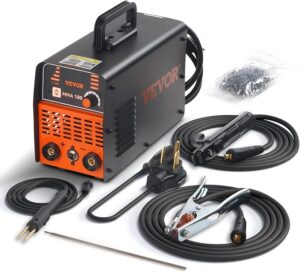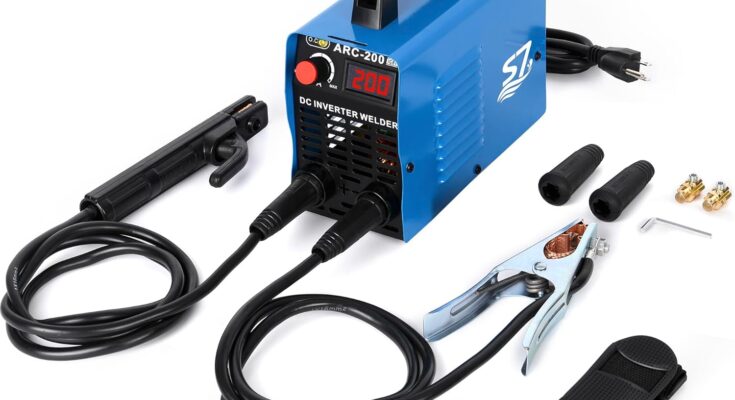Key Advantages of Laser Welding:

Check here for more : https://amzn.to/48WTqlY
Laser welding, a cutting-edge technology, has become a cornerstone in modern manufacturing due to its precision, speed, and versatility. Unlike traditional welding methods that rely on heat from a flame or arc, machine laser welding uses a highly concentrated beam of light to melt and fuse materials together, creating strong, precise welds with minimal thermal distortion. This process has transformed industries such as automotive, aerospace, electronics, and medical device manufacturing, where high-quality, durable joints are crucial.
At the heart of laser welding is the laser itself, which generates a powerful beam of light that is focused onto the workpiece by a series of optical lenses and mirrors. The concentrated heat from the laser melts the material at the weld joint, and as it cools, the metal fuses, creating a strong bond. Because the laser can be tightly controlled, the process offers a high degree of accuracy, even for complex or delicate components.
- Precision and Control: Laser welding provides exceptional control over the heat input and weld size, enabling the creation of fine, intricate welds without compromising material integrity. This makes it ideal for applications where exact tolerances are required, such as in electronics or precision engineering.
- Minimal Heat-Affected Zone (HAZ): Unlike traditional welding methods, laser welding generates a narrow heat-affected zone. This reduces the risk of material distortion or warping, which is especially important in thin or heat-sensitive materials.
- High-Speed and Efficiency: The concentrated laser beam can rapidly melt and join materials, increasing production speed. In automated systems, laser welding can be used in continuous, high-volume manufacturing environments, reducing cycle times and boosting productivity.
- Versatility and Material Compatibility: Laser welding can be used on a wide range of materials, including metals, plastics, and ceramics. It is particularly useful for welding materials that are difficult to join using conventional techniques, such as dissimilar metals or hard-to-weld alloys.
- Automation and Integration: Machine laser welding is highly compatible with automation, making it an excellent choice for industries that require repeatable, high-quality welds in mass production. Robotic systems equipped with laser welding heads can perform precise welding tasks with minimal human intervention, further enhancing operational efficiency.
Applications of Machine Laser Welding:
- Automotive Industry: Laser welding is used extensively in the automotive sector to join lightweight materials, such as aluminum and advanced high-strength steels. It helps reduce vehicle weight while maintaining structural integrity, leading to better fuel efficiency and safety.
- Aerospace: In aerospace, laser welding is employed to join high-strength alloys and ensure the precise and reliable assembly of aircraft components, from turbine blades to fuselage panels.
- Electronics and Micro-manufacturing: Laser welding is ideal for creating small, delicate welds in electronic components, such as circuit boards, battery packs, and connectors. Its precision reduces the risk of damaging sensitive parts while ensuring strong, reliable connections.
- Medical Devices: Laser welding is used to manufacture medical implants, surgical instruments, and diagnostic devices. The ability to make clean, precise welds without introducing contaminants or heat damage is critical in the production of medical-grade components.

Future of Laser Welding:
As laser technology continues to evolve, we can expect even more advanced laser welding techniques that offer greater energy efficiency, faster processing speeds, and the ability to weld a broader range of materials. Innovations in fiber lasers, diode lasers, and ultrafast lasers will likely expand the possibilities of laser welding in industries that demand high precision and reliability.
Machine laser welding represents the future of manufacturing, offering a blend of speed, accuracy, and versatility that traditional welding methods cannot match. Whether it’s creating tiny micro-welds in electronics or joining large, complex structures in aerospace, this technology is transforming industries and setting new standards in manufacturing excellence.




Круглосуточная запись на онлайн-консультацию психолога. Получить КОНСУЛЬТАЦИЮ и ПОДДЕРЖКУ профессиональных психологов. Онлайн-консультация психолога.
Получить первую онлайн консультацию психолога чате. Получить КОНСУЛЬТАЦИЮ и ПОДДЕРЖКУ профессиональных психологов. Психолог t me.
Психологическая и информационная онлайн-помощь. Анонимный чат с психологом телеграм. Психолог онлайн анонимно.
Чат с психологом в телеге. В переписке у психолога. Получить первую онлайн консультацию психолога чате.
Круглосуточная запись на онлайн-консультацию психолога. Онлайн-консультация психолога. Психолог онлайн анонимно.
Психолог онлайн анонимно. Психолог t me. Получите консультацию онлайн-психолога в чате прямо сейчас.
Психолог в телеграм. Психолог онлайн чат. Психолог онлайн анонимно.
Дипломированный психолог с опытом работы и отзывами клиентов. Психолог онлайн чат. Телеграм психолог.
Психолог в телеграм. Психолог t me. Психолог оказывает помощь онлайн в чате.
Получите консультацию онлайн-психолога в чате прямо сейчас. В переписке у психолога. Психолог помогающий искать решения в непростых психологических ситуациях.
Психолог онлайн анонимно. В переписке у психолога. Дипломированный психолог с опытом работы и отзывами клиентов.
Получите консультацию онлайн-психолога в чате прямо сейчас. В переписке у психолога. Дипломированный психолог с опытом работы и отзывами клиентов.
Онлайн-консультация психолога. Онлайн-консультация психолога. Получить КОНСУЛЬТАЦИЮ и ПОДДЕРЖКУ профессиональных психологов.
Психолог помогающий искать решения в непростых психологических ситуациях. Психолог онлайн анонимно. Психологическая и информационная онлайн-помощь.
Психолог онлайн анонимно. Психолог онлайн чат. Психолог оказывает помощь онлайн в чате.
Круглосуточная запись на онлайн-консультацию психолога. Телеграм психолог. Круглосуточная запись на онлайн-консультацию психолога.
Получите консультацию онлайн-психолога в чате прямо сейчас. Психолог онлайн анонимно. Психолог в телеграм.
Помощь психолога онлайн. Круглосуточная запись на онлайн-консультацию психолога. Чат психологической поддержки.
Помощь психолога онлайн. Получить первую онлайн консультацию психолога чате. Дипломированный психолог с опытом работы и отзывами клиентов. оценили 6660 раз
Психолог t me. Онлайн чат с психологом без регистрации. Психолог t me. оценили 9162 раз
Онлайн чат с психологом без регистрации. Психологическая и информационная онлайн-помощь. Круглосуточная запись на онлайн-консультацию психолога. оценили 7264 раз
Психолог онлайн чат. Анонимный чат с психологом телеграм. Психолог оказывает помощь онлайн в чате. оценили 8854 раз
Нужен номер для Телеграма? арендовать номер для телеграмма для безопасной регистрации и анонимного использования. Поддержка популярных регионов, удобный интерфейс, моментальный доступ.
ГГУ имени Ф.Скорины https://www.gsu.by/ крупный учебный и научно-исследовательский центр Республики Беларусь. Высшее образование в сфере гуманитарных и естественных наук на 12 факультетах по 35 специальностям первой ступени образования и 22 специальностям второй, 69 специализациям.
Francisk Skorina https://www.gsu.by Gomel State University. One of the leading academic and scientific-research centers of the Belarus. There are 12 Faculties at the University, 2 scientific and research institutes. Higher education in 35 specialities of the 1st degree of education and 22 specialities.
Create vivid images with Promptchan — a powerful neural network for generating art based on text description. Support for SFW and NSFW modes, style customization, quick creation of visual content.
Недвижимость в Болгарии у моря https://byalahome.ru квартиры, дома, апартаменты в курортных городах. Продажа от застройщиков и собственников. Юридическое сопровождение, помощь в оформлении ВНЖ, консультации по инвестициям.
Срочный выкуп квартир https://proday-kvarti.ru за сутки — решим ваш жилищный или финансовый вопрос быстро. Гарантия законности сделки, юридическое сопровождение, помощь на всех этапах. Оценка — бесплатно, оформление — за наш счёт. Обращайтесь — мы всегда на связи и готовы выкупить квартиру.
Портал о недвижимости https://akadem-ekb.ru всё, что нужно знать о продаже, покупке и аренде жилья. Актуальные объявления, обзоры новостроек, советы экспертов, юридическая информация, ипотека, инвестиции. Помогаем выбрать квартиру или дом в любом городе.
цветы купить онлайн быстрая доставка цветов
глянцевый натяжной потолок установка натяжного потолка кв
дипломная работа на заказ цена заказать дипломная работа
купить готовый реферат онлайн сделать реферат
Путешествуйте интересно экскурсии по Калининграду с гидом по всей области.
заказать реферат недорого написать реферат онлайн
написание дипломной работы на заказ написать диплом
трековые натяжные потолки натяжные потолки спб цены с установкой
машину в аренду недорого взять машину на прокат
прокат авто без водителя суточная аренда автомобиля
ночная экскурсия по калининграду https://ehkskursii-v-kaliningrade.ru
натяжные потолки цена за 1м2 натяжные потолки цена за 1м2 .
стоимость метра натяжного потолка potolkilipetsk.ru .